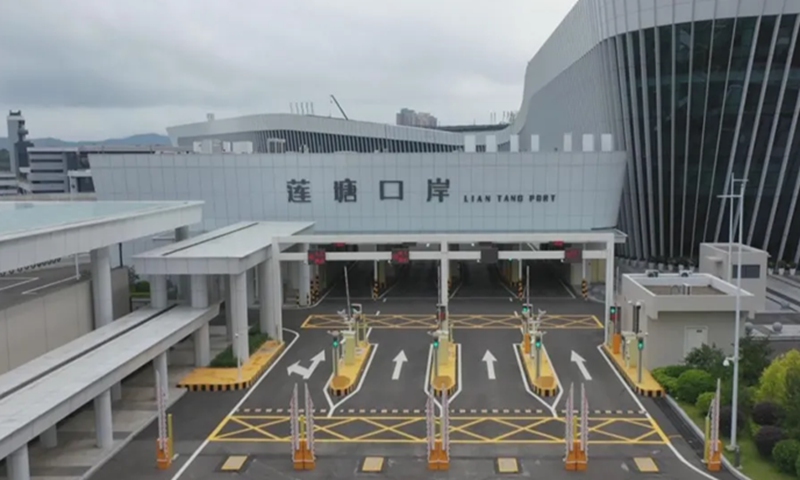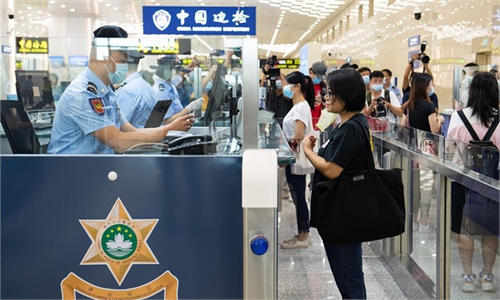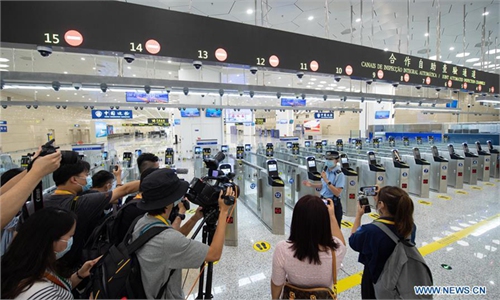Liantang Port opens on Shenzhen SEZ's 40th anniversary
Closer integration among Greater Bay Area cities unstoppable: observers

Liantang Port Photo: Shenzhen Television
On Wednesday, the 40th anniversary of the Shenzhen Special Economic Zone (SEZ), cargo trucks started driving past the Liantang Checkpoint (Heung Yuen Wai Boundary Control Point), the seventh land port at the Hong Kong-Shenzhen border. The port's opening signals that closer integration among cities in the Greater Bay Area is unstoppable, analysts said.
Carrie Lam, Chief Executive of the Hong Kong Special Administrative Region (HKSAR), attended the opening ceremony, saying the facility signals closer ties between the Chinese mainland and Hong Kong, and will greatly reduce the time needed to cross the border and support the "one-hour life sphere" in the Guangdong-Hong Kong-Macao Greater Bay Area.
Cargo clearance started in the afternoon, but border services are not yet available to passengers, private vehicles or coaches due to the COVID-19 epidemic, media reported.
The new port will facilitate links between the HKSAR and eastern Shenzhen. As the port directly connects to highways across the eastern part of Guangdong Province, it will facilitate communications between Hong Kong and the larger region, Hong Kong media reported.
The designed customs clearance capacity of the Liantang Port is 30,000 passengers and 17,850 vehicles per day. With high-tech equipment and 5G coverage, the clearance time at the port can be as little as 10-15 seconds.
Lawrence Tang Fei, a member of the Chinese Association of Hong Kong and Macao Studies, told the Global Times that the opening of the Liantang Port will provide greater convenience for the movement of people and goods between Hong Kong and the Chinese mainland.
Before Liantang, Shenzhen Bay Port was the only port that connected downtown Hong Kong to highways headed to Shenzhen.
Other ports are on ordinary roads with lots of traffic lights, and this causes traffic jams in the northern New Territories, said Tang. Those jams deter people from traveling.
Although traffic volume at the new port is limited due to the coronavirus, Tang stressed that the opening of the new port on the Shenzhen SEZ's 40th anniversary shows that the mainland and Hong Kong are determined to overcome difficulties and accelerate the integration of Hong Kong into the region and the country.
The port project was proposed 12 years ago and approved in 2010. It was co-built by the mainland and Hong Kong starting in 2013 and passed acceptance check in May.
Li Xiaobing, an expert on Hong Kong, Macao and Taiwan studies at Nankai University in Tianjin, told the Global Times that the full operation of the new port will drive the development of the Greater Bay Area.
Hengqin Port — which connects Zhuhai, Guangdong and Macao — opened on August 18, with a yearly customs clearance capacity of 80 million people and 2.5 million vehicles.
The passing of the national security law for Hong Kong cleared the political atmosphere in Hong Kong, and the postponement of Hong Kong's Legislative Council elections due to the COVID-19 pandemic provided a buffer period of political stability for the integrated development of the area, Li noted.
The continuous and deep integration of Hong Kong and the mainland in terms of their economies, cultures and livelihoods is the direction for the "one country, two systems" policy, said Li, noting with the support of the central government, Hong Kong and Macao have drawn on one another's strengths, and they are exploring a high-quality development model in the Greater Bay Area.
The concept of a "one-hour living sphere" is coming true. A Shenzhen resident told the Global Times that with the operation of Shenzhen Bay port in western Shenzhen and the new Liantang port in the eastern part, the two cities have an increasingly seamless connection.
"Hong Kong is indeed within an hour from Shenzhen and it only takes 14 minutes from Kowloon to downtown Shenzhen by high-speed train," the resident said, noting he has many friends who work in Hong Kong on weekdays and come to Shenzhen on weekends to eat hot pot and sing at karaoke parlors.



